I know, I know. Salt Fish. That is the most uninteresting protein ever, right? Wasn’t that the terrible salt thick fish that the pilgrams had to eat? Is that what they call ‘squaw candy?’ Or how about the dry-fish of the Alaska Natives? But use the word ‘lox‘ and suddenly it’s a priceless cut?!
With all the great fresh fish options we have available in Anchorage, you are probably wondering, “Why would she bother with salted fish?” It all goes back to the same horrifying story. Growing up inland in semi-rural Alaska meant that we often ate what meat was available. For fish this meant salmon. We didn’t get halibut or crab. We didn’t eat clams or muscles. It was salmon. Salmon, salmon, salmon… and only cooked one way. You headed it. You gutted it. You froze it. When it was time to eat your salmon you put the whole thing in the oven at 350 degrees and baked it for 45 minutes. That’s right folks… 45 minutes of salmon filled air in your home (plus the hours it lingered after). And that air you are tasting? It contains every single ounce of moisture that that fish ever contained. That’s okay, right? We’d have tartar sauce on the side. Yup, homemade tartar sauce containing nothing but mayonnaise and pickle relish. (If you didn’t know before now why I don’t exactly relish the distinct flavor of salmon, why I loath mayo, and why I never put relish on my hotdog… now you do.)
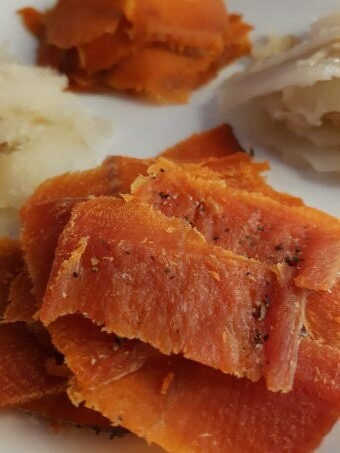
So this explains why I am on such a life mission to discover new ideas about how to cook and use fish (and all the other sea foods that I never got to try) in ways that aren’t boring and may actually contain some flavor! Perhaps even amazingly so! Through this, maybe, just maybe, my son will not grow up loathing it.
So back to the Lox:
There were a couple of influences to my trying my/a hand at lox. We have a locally famous German immigrant by the name of Herb Eckmann who has owned and operated Alaska Sausage and Seafood for almost 55 years. He is always raving about his salmon lox on the radio with his thick accent. I also have a good friend on the Kenai Peninsula who is very proud of his own lox. In fact one of my old coworkers once tried it and decided “it wasn’t for him” and the man straight-up ended their friendship there and then. No joke. True story. So what’s the deal?
Well, Lox is…..
- In Yiddish לאַקס/Lox/Laks=Salmon
- In German Lachs=Salmon
- In Scandinavian Countries Lox/Laks=Salmon
- …it all pretty much goes back to the Indo-European word Laks=Salmon
(But that’s straight out of Wiki.)
For something a little more meaty:
- Lox refers to a dry-brined and cured salmon, usually a mix of salt and sugar.
- Gravlox refers to the same dry-brined salmon but with the addition of dill and sometimes juniper. ‘Grav’ is short for grave (both known in Scandinavia and Scotland) and refers to the original practice of burying the fish, which is now accomplished by the addition of weight during the curing process.
- For anyone, perhaps from the East Coast, who is familiar with Nova or Nova Lox, that refers to lox that is most likely salmon caught or processed in Nova Scotia, or of that style.
*Note: The initial drying part of this process is very important. Using either the natural wind or a fan the salmon needs to be able to form a ‘pellicle’, or thin skin layer, so that the smoke will then have something to cling to while still preserving some moisture inside.

Painted in 1603, the detail and number of characters in this painting just amazes me. I love the use of shadowing over the people under and near the tree, and then the brightness of the activities happening farther down the hill in the more direct sunlight. I just feel that this painting really brings home why salting, pickling, and smoking fish and other meats became so critical. What an interesting time period in which to have lived!
So what did I do with all this?
For my own personal first attempt at lox I took a gravlox recipe and instead of using dill I used fresh lemon thyme.
- 2 t lemon thyme
- 1/2 cup salt
- 1 cup sugar
- 3/4 salmon fillet
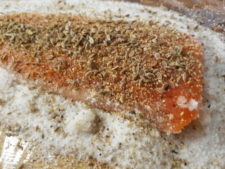
I did as instructed (although I forgot to take out any pin bones) and let it sit on the counter wrapped for 6 hours and then in the fridge. I didn’t get to serving it after the next 18 hours but instead opened and sliced it at 24 hours. It was great! the texture was firm and I could taste the subtle flavors of the lemon thyme. It was neither too salty nor under salted…. but it still tasted like salmon does… salmony.
Now I know that I have a personal issue with the straight flavor of salmon, that many other people really enjoy, and although it was more subdued, it was still there. I know, it’s probably just me, but I needed to find a way to tone down that ‘salmony-ness’ even more.
For my second attempt, liking the dry slice-ability of the salted fish, I decided to use cod. I went with a simple straight forward dry brine with a good helping of lemon pepper, and a second one with thinly sliced fresh ginger. Each is made again with the ratio of 1 part salt and 2 parts sugar.
I cut the thickest halves off of several fillets and because there is no skin I decided to sandwich the fish between two salt layers. This worked well, however I’ve learned that I need to make sure the brine layers are not too thick since it’s being received from both sides.
I was completely thrilled with the way that these two batches came out!
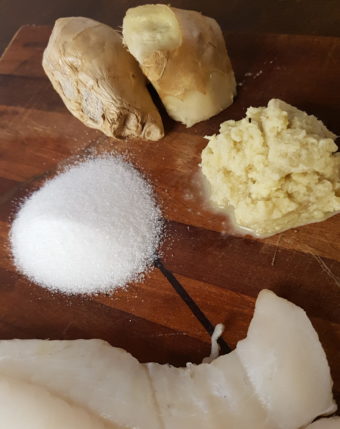
I have discovered through repeated attempts that using the fresh ginger tends to make the outer layer of the cod a bit soft, and, I hate to say, even gummy-like. However, that has not affected any spoilage issues and the flavor is absolutely amazing! Of all of the flavors I have tried for salting fish and making lox, perhaps it’s just a personal preference toward ginger in general, I could keep gingered fish on hand always and be a very happy girl! Think of all the ways it can be used! Pho and other soups, sushi, crackers, pot-stickers and dumplings… okay, that list isn’t that but long you get the idea.
So repeating the ginger, of course, I also tried my hand at the salmon again. This time I used an applewood smoked sea salt in the brine. Since this salt has a very powerful amount of smokey fragrance I decided to use half smoked and half regular sea salt. To be totally honest I don’t think there could ever be too much smokey-ness added to salmon for me, and I am inclined to use all smoked salt for my own personal lox, but for the recipe below I left it as half-and-half.
LONG STORY SHORT, there are a lot of ways to prepare and preserve salmon (and all other manner of fish) with salt, sugar, smoke, and/or heat.
Suggestions for Herb or Seasoning Choices for Lox or Salted Fish:
- Fresh Dill and/or dill seed
- Fresh Lemon Thyme
- Fresh Basil
- Fresh Ginger
- Cracked Black Pepper
- Lemon Pepper
- Garlic Salt
- Paprika – Smoked or Sweet
- Dried Chipotle
- Red Pepper Flake or other chili
- Wasabi or Horseradish
- Lemon, Lime, or Orange Zest
- Mustard Powder
- Garam Masala
- Cajun or Creole
- Dry BBQ Rub
- Curry Spice Mix
- Adobo
- Other Favorite Seasoning Mix or Season Salt
- Try marinading the fish with a salt based liquid flavor before salting:
- Worcestershire
- Soy Sauce
- Ponzu
- Tabasco
Below I have listed 4 styles of lox salmon and/or other fish that truly are worth trying.
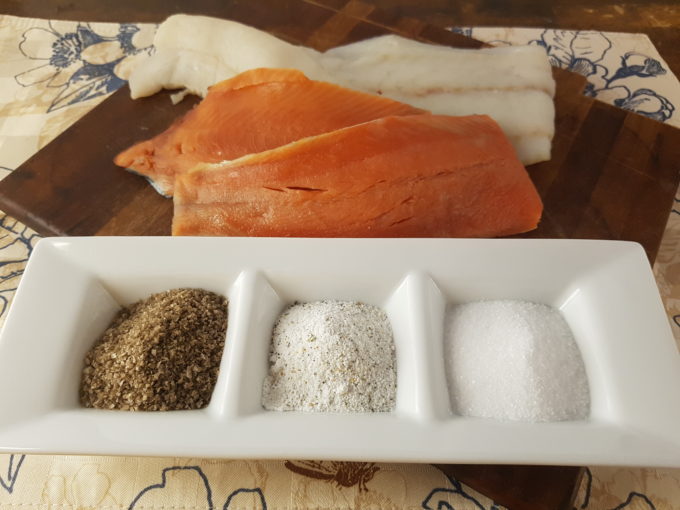
Classic Lox
Ingredients
- ½ to 1 pound salmon fillet
- ½ cup fine sea salt
- 1 cup granulated sugar
Instructions
- Wash the fillet, and remove any pin bones using needle nose pliers or tweezers.
- Over a large sheet of plastic wrap lay the salmon skin down. Mix the sugar and salt in a bowl, and cover the fillet with a solid layer of this mixture.
- Wrap the fillet fully with the plastic wrap and place it on a plate or tray. Allow to sit out on the counter for 6 hours.
- Place another plate or flat item over the wrapped fish with something to weigh it down. Let rest in the fridge for 18 to 24 hours (or even longer), pouring off any drained liquid periodically.
- Remove the fish from wrap and rinse. Pat dry. Slice as thin as possible with a chef or fillet knife. Your lox is ready to serve! Store your lox covered in the fridge.
Gravlox
Ingredients
- ½ to 1 pound salmon fillet
- ½ cup fine sea salt
- 1 cup granulated sugar
- 1 large bunch fresh dill
Instructions
- Wash the fillet, and remove any pin bones using needle nose pliers or tweezers.
- Over a large sheet of plastic wrap lay the salmon skin down. Mix the sugar and salt in a bowl. Cover the fillet with the fresh dill then a solid layer of the salt and sugar mixture.
- Wrap the fillet fully with the plastic wrap and place it on a plate or tray. Allow to sit out on the counter for 6 hours.
- Place another plate or flat item over the wrapped fish with something to weigh it down. Let rest in the fridge for 18 to 24 hours (or even longer), pouring off any drained liquid periodically.
- Remove the fish from wrap and rinse. Pat dry. Slice as thin as possible with a chef or fillet knife. Your gravlox is ready to serve! Be sure to store it covered in the fridge.
Gingered Salt Cod
Ingredients
- ½ to 1 pound cod fillet
- ½ cup fine sea salt
- 1 cup granulated sugar
- 1 large lobe fresh ginger; peeled and thin sliced or grated
- other herbs/spices as desired. (See suggestions above.)
Instructions
- Mix the sugar and salt in a bowl. Over a large sheet of plastic wrap make a layer of this mixture the same shape as your fillet. Lay half of the sliced or grated ginger over this and then the fillet. Cover the top of the fillet with the rest of the ginger and a thin layer of the salt and sugar.
- Wrap the fish fully with the plastic wrap and place it on a plate or tray. Allow to sit out on the counter for 6 hours.
- Place another plate or flat item over the wrapped fish with something to weigh it down. Let rest in the fridge for 18 to 24 hours (or even longer), pouring off any drained liquid periodically.
- Remove the fish from wrap and rinse. Pat dry. Slice as thin as possible with a chef or fillet knife. Your cured fish is ready to serve! You’ll need to store your salt fish covered in the fridge.
Notes
Smoked Salt Lox (or Cod)
Ingredients
- ½ to 1 pound salmon fillet (or cod)
- ¼ cup fine sea salt
- ¼ cup smoked sea salt*
- 1 cup granulated sugar
- optioinal – herbs or seasoning of personal preference
Instructions
- Wash the fillet, and remove any pin bones using needle nose pliers or tweezers.
- Over a large sheet of plastic wrap lay the salmon skin down. Mix the sugar and salts in a bowl. If using, cover the fillet with the fresh herbs and/or sprinkle with seasoning, then cover with a solid layer of the salt and sugar mixture.
- Wrap the fillet fully with the plastic wrap and place it on a plate or tray. Allow to sit out on the counter for 6 hours.
- Place another plate or flat item over the wrapped fish with something to weigh it down. Let rest in the fridge for 18 to 24 hours (or even longer), pouring off any drained liquid periodically.
- Remove the fish from wrap and rinse. Pat dry. Slice as thin as possible with a chef or fillet knife. Your cured fish is ready to serve! Store it covered in the fridge.

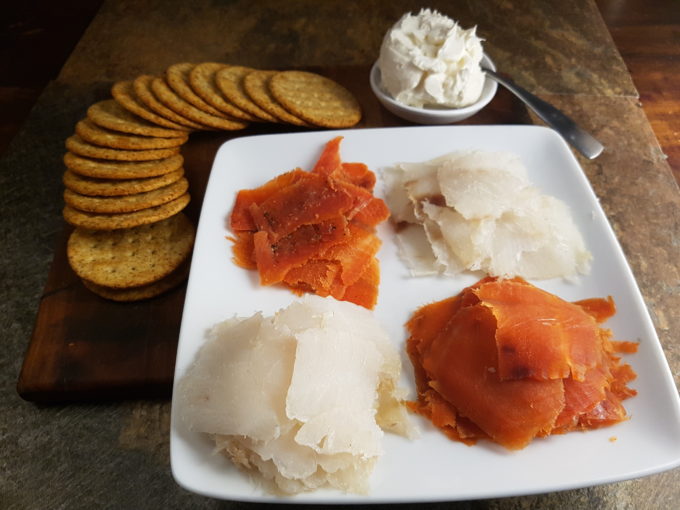
Post a comment